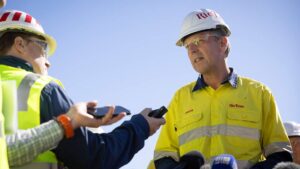Monsters of Rock: Simandou a ‘win-win’ and Silver Lake lobs shock bid for Gwalia

Pic: Flashpop/Stone via Getty Images
- Rio shareholders gathered in Perth for the Australia leg of its AGM
- CEO Jakob Stausholm says Simandou development will is shaping as a ‘win-win’ for Rio and Guinean stakeholders
- Silver Lake crashes Genesis and St Barbara’s Gwalia party
Investors have plenty of reason to be sceptical about the logic of Rio Tinto (ASX:RIO) spending the big bucks to take part in the multi-billion dollar development of the Simandou iron ore mine in Guinea.
The project will require the construction of hundreds of kilometres of rail through the tough terrain of the Guinean jungle, by some accounts through the habitat of a rare chimpanzee, it’s come under scrutiny from NGOs and could potentially be leveraged by Chinese steel makers to replace the Australian iron ore the very same Rio Tinto produces at its Pilbara operations.
On the other hand Rio has been keen to do something with its stake in two of four blocks at the largest undeveloped iron ore deposit in the world since it made the discovery in the mid-1990s.
Having operated in the West African country — on the path back to democracy after a coup two years ago — for several decades, Rio is understandably interested in realising some value for that grind.
Simandou also contains direct shipping ore in the order of 65% Fe, comparable at scale only to the northern operations of Brazilian iron ore producer Vale, and something Rio thinks could see it supply lower emissions steelmakers in the future.
Previously sovereign risk, illogical logistics requirements and a whiff of corruption have made the project impossible to deliver.
Now, the ducks are finally lining up, with current Rio CEO Jakob Stausholm telling shareholders at the Anglo-Australian mining giant’s 150th anniversary AGM in Perth today that the JV between the corporate partners and Guinean Government to develop Simandou and its associated port and rail infrastructure was now signed, hoping to see the project move into “full execution” soon.
“Win-Win”
Simandou came back on the agenda a couple years ago as iron ore prices recovered following the partial closure of Vale’s operations in response to the Brumadinho dam disaster in January 2019, eventually peaking at a record US$237/t in May 2021.
Singapore prices fell 1.7% to trade under US$100/t this afternoon for the first time in 2023, with a strong start to the year for Chinese steel producers petering in recent days amid a crunch on mill margins.
Conducting a Q & A session with investors both online and in person, Stausholm brushed off investor queries about sovereign risk in Guinea, saying the Simandou development would be a “win-win” for the company and the country’s economy.
Historically a strong hub for gold and bauxite production, iron ore developments have so far proved too substantial and contentious for the politically volatile West African nation, while fluctuations in the iron ore price over time have not helped the development case.
“It is, of course, something we have given some deep thoughts to that, given the fact that the Simandou project, if going ahead shortly will be perhaps the biggest at the moment global mining project,” Stausholm said.
“It is progressing very well and you heard in my speech that I spoke positively about it and as the starting point is that we feel comfortable with the sovereign risk in that sense, that is not a static factor.
“I mean, it’s a developing country Guinea, and there is a transitionary government. But they have committed to a move back to democracy and they are following all the milestones, and they have the support of a number of international governments.
“So our project and the government in Guinea, are having wide international support. And on that basis, we feel comfortable by investing in the country also.
“Because we believe that this investment can really, really develop the country. So there’s this such a big win-win. And that’s always a good starting point to go into an investment.”
Rio Tinto (ASX:RIO) share price today:
Silver Lake rejected in 11th hour bid to trump Genesis for Gwalia
St Barbara’s long courtship by Genesis Minerals (ASX:GMD) has taken many twists and turns, converting from a merger to a kind of reverse takeover to a sell off of its flagship Gwalia mine.
The deal would see Genesis, led by former Saracen and Northern Star boss Raleigh Finlayson, pay $370m cash and issue 147.8m shares worth $170m, along with another $60m in shares once Tower Hill is in production, to mop up Gwalia.
St Barbara would have its debts paid and walk off with the Atlantic operations in Canada and Simberi mine in PNG, while Finlayson would be free to consolidate the Leonora gold district under one umbrella.
`RECORD SCRATCH`.
In walks a far bigger dog in the fight, Silver Lake Resources (ASX:SLR), a mid-tier gold miner in the 250,000ozpa category, which issued a media statement today telling the market St Barbs had knocked back a competing proposal to acquire the Gwalia mine from under Finlayson’s nose.
In Silver Lake’s estimation its $732m offer of $326m cash and 327.1m shares with no contingent consideration came in at a 28% premium to Genesis’ base offer and 14% if the Tower Hill contingency was triggered.
The deal would have given St Barbs shareholders a 26% interest in Silver Lake. SLR says St Barbs’ two biggest shareholders L1 Capital and Baker Street Capital Managers, who hold a collective 17.9% of SBM, are supportive of it engaging with Silver Lake and grant due diligence.
Why did this not appeal to the St Barbara board, which continues to unanimously back the Genesis bid?
Once the tax and break fee to Genesis is taken into account they say the premium sits at just 9%.
They don’t like the uncertainty either. Silver Lake will only make the offer binding once the two week due diligence period is up, leaving the risk it could walk away and leave SBM holding the baby.
Even if that isn’t the case, SBM says the deal would face the risk of being scuttled by an independent expert’s report, would need the approval of both sets of shareholders and could take up to two months longer to wrap than the planned June 30 date for Genesis to complete its acquisition.
Of course the big question for investors may be who is best to return Gwalia to its former glory. The main driver behind a major turnaround that once made SBM a market darling five years ago, Gwalia was once one of Australia’s lowest cost gold mines.
By contrast, it is expected to deliver just 130-135,000oz at all in sustaining costs of $2650-2750/oz, leaving barely any margin to the Aussie dollar gold price even at record levels in excess of $3000/oz.
Gwalia imbroglio share price today:
Related Topics

UNLOCK INSIGHTS
Discover the untold stories of emerging ASX stocks.
Daily news and expert analysis, it's free to subscribe.
By proceeding, you confirm you understand that we handle personal information in accordance with our Privacy Policy.








